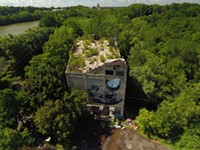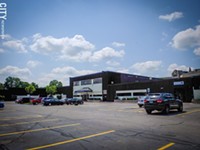[
{
"name": "500x250 Ad",
"insertPoint": "5",
"component": "15667920",
"parentWrapperClass": "",
"requiredCountToDisplay": "1"
}
]
A graffiti-covered building hulks over the end of Flint Street — a dilapidated monument on a blighted landscape in southwest Rochester's Plymouth-Exchange neighborhood.
The building is part of the Vacuum Oil site, a 24-acre property along the Genesee River waterfront that once held an oil refinery (it shut down in the 1930's). In the decades that followed, parts of the site were used for various other purposes, including a junkyard.
But neighbors and city officials see potential in the site. Instead of decay and debris, they see the possibility of an inviting and publicly accessible waterfront with new mixed-use development nearby.
"In an urban neighborhood that is perceived as unattractive, we've got one of the most attractive assets: the waterfront itself," says John Curran, chair of a PLEX Neighborhood Association waterfront revitalization subgroup.
Making that vision a reality will be a challenge, however. The Vacuum Oil site is contaminated from its past life as an industrial campus and requires expensive cleanup work. It's what's known as a brownfield, a vacant or underused property with actual or potential pollution that complicates redevelopment. The whole site fits the commonly accepted definition, but two parcels are officially enrolled in the state's Department of Environmental Conservation Brownfield Cleanup Program.
There are brownfields in practically every community in the state, says Linda Shaw, an attorney with the Knauf Shaw law firm, which specializes in environmental law, including brownfield matters. By some estimates there are more than 10,000 potential brownfields in New York.
And developers aren't exactly drawn to them; many are discouraged by the costs and complexity associated with the cleanup work. That's left communities, including Rochester, wrestling with the question of what to do with their brownfields.
"You don't quite know what you're getting into before you've spent sometimes a pretty good amount of money," says Mark Gregor, the City of Rochester's manager of environmental quality.
The state and federal governments have stepped in with programs to relieve the cost and technical burdens posed by the sites. They provide local governments with cleanup funding or give developers incentives to tackle the sites. A recent report from the state Comptroller's Office says that between 2008 and 2012, New York granted brownfield tax credits worth $188 million a year, on average.
But government resources are limited, so the programs can only accomplish so much. And that has led to a debate about who should benefit. It's complicated, in part because the programs, like the sites they address, are complicated.
But there's a simple, dirty fact about brownfields: while suburbs like Perinton or Scottsville may have a few brownfield sites between them, brownfields tend to be concentrated in urban areas, particularly in poorer neighborhoods.
For example, the Vacuum Oil site is in a census tract where 75 percent of families with children under age 18 have incomes below the poverty line. And in the 14621 zip code, where more than 80 potential brownfields have been identified, approximately 49 percent of families with children under age 18 have below-poverty incomes.
New York lawmakers are beginning to discuss renewing or replacing the state's brownfield cleanup and redevelopment tax credits for developers, which expire at the end of 2015. Some legislators and advocacy groups are pushing for the credits to be better targeted to distressed communities and low- and moderate-income neighborhoods.
The chief criticism of the tax credit program is that the incentives have mostly gone to higher-value projects in desirable real estate markets. Critics point to projects in downtown Manhattan and housing projects in well-to-do suburbs — projects built on cleaned-up brownfields — as examples.
"We've spent about $1.23 billion in tax credits — these are tax credits that have been claimed so far — and we've only cleaned up about 129 sites," says Andrew Postiglione, a fiscal policy program associate at Environmental Advocates of New York. His organization is one of several advocating for the credits to go to lower-income areas.
Shaw, the environmental attorney, says that just because a site is in a more affluent neighborhood doesn't mean cleaning it up is any less costly, and without some sort of incentive, a developer still may not make an adequate return on investment.
And the existing state program does award larger credits for sites in distressed neighborhoods and state-designated Brownfield Opportunity Areas, she says. The BOA program provides grants for local governments and community organizations to do planning work around large or concentrated brownfields. The process relies heavily on resident and business input, and the end result is a detailed revitalization plan.
Shaw also says that in recent years, upstate projects have been taking better advantage of the credits.
She looks at the tax credits as an investment program. For the cost of the credits, developers clean up and reuse the sites, which not only gives local governments more tax revenue, but generally improves the surrounding communities, she says. The benefits just aren't always easy to measure, she says.
"Without a tax credit program, I don't see how any of these brownfield neighborhoods, where you've got multiple brownfields next to each other, can get redeveloped," she says.
The city and the PLEX neighborhood are using the state's Brownfield Opportunity Areas program to plan for the Vacuum Oil site's future.
By using a community-driven process, redevelopment efforts can be targeted to a neighborhood's needs, whether it's housing, jobs, or even a grocery store. In the case of the Vacuum Oil plan, residents stressed keeping the Genesee River waterfront publicly accessible. They also said they didn't want the neighborhood to become gentrified, says Joan Roby-Davison, executive director of the Sector 4 Community Development Corporation.
The city's Gregor says that the plans can help communities attract development by providing clarity about property conditions, particularly environmental conditions. They also lay out how the communities would ultimately like brownfield sites used, he says.
The BOA program is less than a decade old, but several areas in the City of Rochester are already going through the process; the Vacuum Oil site was one of the first applications made by Rochester officials.
Planning efforts are ongoing in the 14621 area, where much of the focus is on improving recreation and housing opportunities, as well as rehabilitating commercial corridors. The Lyell-Lake-State area plan is still in its early stages, but some cleanup work is happening, including work at the former Delco plant between Whitney and Orchard streets.
The proposed Bull's Head Brownfield Opportunity Area spans 188 acres and includes more than 100 potential brownfield sites. The city and Sector 4 Community Development Corporation are awaiting approval of the BOA application.
The proposed plan area includes the plaza at West Main and Genesee streets. It also includes the former Taylor Instruments site, a concrete-covered lot across the street from the Danforth Community Center.
A couple of years ago, neighbors beat back a proposal to turn the site into a salvage yard. Residents asked that the property be included in the BOA plan with the hope they could avoid similar proposals in the future.
The owners want to sell the property, Roby-Davison says. But many potential buyers are put off by the mercury contamination on the site, she says.
The Newcroft Park housing tract in the North Winton Village neighborhood successfully used a different brownfield redevelopment approach: the city cleaned up the site before selling lots to private builders.
Newcroft Park was once a contractor's lot surrounded by residential properties. But the properties' owner was substantially behind on the property taxes and, after years of citizen complaints about operations on the site, the city foreclosed.
After an environmental assessment and cleanup that included removal of contaminated soil, construction debris, and asbestos, the city carved up the property into 22 smaller lots.
The project started in 1996 and all of the lots were sold over the course of one weekend in 2004. The 22 houses now located on the site contribute about $200,000 to $250,000 in tax revenue annually, Gregor says. And property values in the surrounding neighborhood have gone up, too, he says.
Gregor calls the project a "homerun-type success story."
But the state program that funded the cleanup, the dryly-named Environmental Restoration Program, hasn't accepted new applications since 2008. In fact, until New York lawmakers passed the 2013 to 2014 state budget, the program was flat broke.
This year's state budget includes $12 million to replenish the program, which provides cleanup funding to local governments and community-based organizations. But with $40 million worth of projects waiting for funding, it'll only make a small dent.
Legislation introduced in the US Senate could add more funding for municipal and nonprofit cleanups. The bipartisan BUILD Act would expand an existing EPA grant program.
But some sites are so polluted that private developers won't touch them, even with tax incentives, Gregor says.
"That's a role for government," he says. "When the marketplace is failing and you've got issues of crime, public safety, health... That's where government does need to step in and at least start the process."
Speaking of...
-

Who’s going to clean up the mess in PLEX?
Sep 2, 2020 -

City seeks developer to lead Bull's Head effort
Jul 20, 2020 -

Colgate Divinity neighbors lose court battle to stop development
May 13, 2020 - More »
Latest in News
More by Jeremy Moule
-

ROCHESTER TEN
ANNETTE RAMOSAug 1, 2023 - More »








